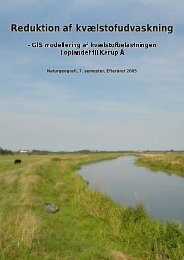Deglaciation dynamics following the Little Ice Age on Svalbard:
Deglaciation dynamics following the Little Ice Age on Svalbard:
Deglaciation dynamics following the Little Ice Age on Svalbard:
Create successful ePaper yourself
Turn your PDF publications into a flip-book with our unique Google optimized e-Paper software.
Søren H. Rasmussen<br />
<str<strong>on</strong>g>Deglaciati<strong>on</strong></str<strong>on</strong>g> <str<strong>on</strong>g>dynamics</str<strong>on</strong>g> <str<strong>on</strong>g>following</str<strong>on</strong>g> <str<strong>on</strong>g>the</str<strong>on</strong>g> <str<strong>on</strong>g>Little</str<strong>on</strong>g> <str<strong>on</strong>g>Ice</str<strong>on</strong>g> <str<strong>on</strong>g>Age</str<strong>on</strong>g> <strong>on</strong> <strong>Svalbard</strong>:<br />
Implicati<strong>on</strong> of debris-covered glaciers dynamic and morphological setting<br />
Figure 6. Oblique view of Larsbreen’s moraine. View toward South-south-west, 30 th September 2000<br />
(Humlum, 2005).<br />
At <str<strong>on</strong>g>the</str<strong>on</strong>g> eastern margin of <str<strong>on</strong>g>the</str<strong>on</strong>g> fr<strong>on</strong>tal<br />
moraine <str<strong>on</strong>g>the</str<strong>on</strong>g>re is a ridge. Toward <str<strong>on</strong>g>the</str<strong>on</strong>g> main<br />
surface meltwater channel <str<strong>on</strong>g>the</str<strong>on</strong>g>re is a gentle<br />
slope and towards moraine margin <str<strong>on</strong>g>the</str<strong>on</strong>g><br />
slope is steeper. The ridge is c<strong>on</strong>tinuing<br />
towards <str<strong>on</strong>g>the</str<strong>on</strong>g> fr<strong>on</strong>t of <str<strong>on</strong>g>the</str<strong>on</strong>g> fr<strong>on</strong>tal moraine.<br />
On <str<strong>on</strong>g>the</str<strong>on</strong>g> outside of this ridge are rock<br />
glaciers. There is a clear shift in sediments<br />
between <str<strong>on</strong>g>the</str<strong>on</strong>g> moraine and <str<strong>on</strong>g>the</str<strong>on</strong>g> rock glaciers,<br />
see figure 6. The moraine is c<strong>on</strong>sisting of<br />
diamict<strong>on</strong> from clay to clasts, where <str<strong>on</strong>g>the</str<strong>on</strong>g><br />
surface of <str<strong>on</strong>g>the</str<strong>on</strong>g> rock glacier is <strong>on</strong>ly clasts.<br />
Talus c<strong>on</strong>es are present al<strong>on</strong>g <str<strong>on</strong>g>the</str<strong>on</strong>g> eastern<br />
Page 9 of 15<br />
valley side. The sediment <strong>on</strong> <str<strong>on</strong>g>the</str<strong>on</strong>g> talus<br />
c<strong>on</strong>es and <str<strong>on</strong>g>the</str<strong>on</strong>g> rock glaciers is <str<strong>on</strong>g>the</str<strong>on</strong>g> same<br />
type.<br />
Discussi<strong>on</strong><br />
Debris-covered glaciers<br />
Classificati<strong>on</strong> of Larsbreen and Platåbreen<br />
as debris-covered glacier, like Lukas<br />
et al. (2006) points out, are important for<br />
understanding <str<strong>on</strong>g>the</str<strong>on</strong>g> two glaciers moraines.<br />
Lønne (2006) is also making it clear that<br />
<str<strong>on</strong>g>the</str<strong>on</strong>g> moraine at Platåbreen is not cored with<br />
dead-ice. This means that <str<strong>on</strong>g>the</str<strong>on</strong>g> active glacier<br />
Figure 7. Left, mouth of meltwater channel at <str<strong>on</strong>g>the</str<strong>on</strong>g> base of Larsbreen fr<strong>on</strong>tal moraine. Right, ice cave<br />
<strong>on</strong> Larsbreen fr<strong>on</strong>tal moraine, situated west of <str<strong>on</strong>g>the</str<strong>on</strong>g> sou<str<strong>on</strong>g>the</str<strong>on</strong>g>rn meltwater lake.







